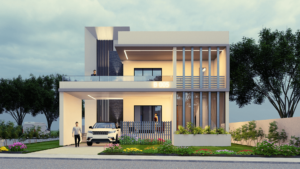Plastering is a crucial process in construction that enhances the strength, durability, and appearance of walls and ceilings. It provides a smooth and protective layer that prevents damage from environmental factors while also improving the overall aesthetics of a building.
A well-applied plaster layer ensures that the walls are uniform, crack-free, and resistant to weather conditions, making it an essential finishing step in both residential and commercial construction projects.
By the end of this article, you will have a clear understanding of plastering and how it contributes to a well-finished, long-lasting structure.
Table of Contents
ToggleWhat is Plastering in Construction?
Plastering is the process of applying a layer of plaster mixture (cement, sand, water, and sometimes lime or gypsum) to walls and ceilings to create a smooth, durable, and protective surface.
This coating helps to:
Cover rough and uneven wall surfaces
Provide a base for painting, tiling, or wallpapering
Protect walls from moisture, cracks, and external damage
Plastering has been used in ancient architecture and continues to be an integral part of modern construction due to its protective and aesthetic properties.
Purpose of Plastering in Construction
Plastering serves multiple functions in construction, making it an essential step in any building project. Here’s why it is important:
1. Creates a Smooth and Even Surface
Unplastered walls have an uneven texture with visible brickwork or concrete joints. Plastering creates a uniform and polished finish, making it ideal for painting, tiling, or decorating.
2. Provides Protection Against Weather and Moisture
A good plaster layer seals the walls, preventing water seepage, mold growth, and structural weakening due to humidity. This is especially important in bathrooms, kitchens, and exterior walls exposed to rain.
3. Increases Durability and Strength
Plastered walls are more resistant to wear and tear, reducing the chances of cracks, chipping, or erosion over time. This increases the lifespan of the building.
4. Enhances Aesthetic Appeal
Different types of plaster finishes, such as textured, smooth, or decorative, improve the visual appeal of interiors and exteriors.
5. Offers Thermal and Sound Insulation
Some plaster materials provide heat and noise insulation, making indoor spaces more energy-efficient and soundproof.
6. Prevents Dust Accumulation
Bare concrete or brick walls tend to generate dust, which can affect indoor air quality. Plastering seals the surface, making maintenance easier and dust-free.
Types of Plastering in Construction
Different types of plaster are used depending on the material, application, and finish required. Below are the most common types:
1. Cement Plaster
Material: Cement, sand, water
Best For: Interior and exterior walls
Features: Strong, durable, and resistant to moisture
Application: Applied in one or two coats, followed by a finishing coat for smoothness
2. Lime Plaster
Material: Lime, sand, water
Best For: Old and heritage buildings
Features: Flexible, breathable, and mold-resistant
Application: Used for historical restorations and in buildings where moisture control is required
3. Gypsum Plaster
Material: Gypsum, water
Best For: Interior walls and ceilings
Features: Lightweight, quick-drying, and smooth finish
Application: Popular in modern homes and commercial buildings
4. Mud Plaster
Material: Clay, water, organic matter (straw, cow dung)
Best For: Eco-friendly homes, rural houses
Features: Environmentally friendly, naturally insulating
Application: Used in sustainable and traditional homes
5. Stucco Plaster
Material: Cement, lime, sand, water
Best For: Decorative and exterior surfaces
Features: Hard, durable, and weather-resistant
Application: Often used for ornamental and textured finishes in Mediterranean-style homes
Step-by-Step Plastering Process in Construction
Achieving a high-quality plaster finish requires a systematic approach. Below is a detailed step-by-step guide:
1. Surface Preparation
Remove dust, dirt, grease, and loose materials from the wall.
Apply water to prevent rapid drying of the plaster.
Fill large cracks and holes with cement mortar.
2. Mixing the Plaster
The cement-to-sand ratio usually ranges from 1:3 to 1:6, depending on the surface.
The mixture is blended thoroughly with water until it reaches a smooth, lump-free consistency.
3. Applying the First Coat (Scratch Coat)
A rough 10-12mm thick layer is applied to create a strong base.
The surface is then scratched using a trowel to form grooves for better adhesion of the next layer.
4. Applying the Second Coat (Floating Coat)
A smoother 6-8mm thick layer is applied over the first coat.
The surface is leveled using a wooden float to eliminate imperfections.
5. Applying the Final Coat (Finishing Coat)
A thin 2-3mm finishing coat is applied for a polished and refined look.
Depending on the desired style, finishes like smooth, textured, or decorative patterns can be created.
6. Curing the Plaster
The plastered surface must be kept damp for at least 7-10 days to prevent cracking.
Proper curing ensures that the plaster hardens effectively and remains durable.
Benefits of Plastering in Construction
Enhances Structural Strength – Protects walls from damage and increases their lifespan.
Prevents Cracks and Shrinkage – Reduces the risk of cracks, maintaining the integrity of the structure.
Improves Aesthetics – Provides a smooth and polished surface for an elegant finish.
Weather Resistance – Acts as a shield against moisture, preventing water absorption.
Easy Maintenance – Plastered walls are easy to clean and repaint when necessary.
Fire Resistance – Certain types of plaster, such as gypsum, offer fire-resistant properties.
Sustainable Options – Eco-friendly plasters, like lime and mud plaster, support sustainable construction.
Key Considerations for High-Quality Plastering
Material Quality – Use high-quality cement, sand, and additives to ensure durability.
Mix Proportions – Follow the correct ratios for strength and stability.
Surface Preparation – Properly clean and wet the wall before application.
Weather Conditions – Avoid plastering in extreme heat or rain to prevent defects.
Proper Curing – Ensure sufficient curing time to enhance strength and longevity.
Skilled Workforce – Hire experienced plasterers to achieve a smooth and flawless finish.
Conclusion
Plastering is an essential step in construction that enhances durability, protection, and aesthetic appeal. Whether you choose cement, gypsum, or lime plaster, following the right process and considerations ensures a high-quality finish.
If you are planning a construction or renovation project, SmartScale House Design can help you achieve the perfect finish with expert plastering solutions. Contact us today to discuss your project







